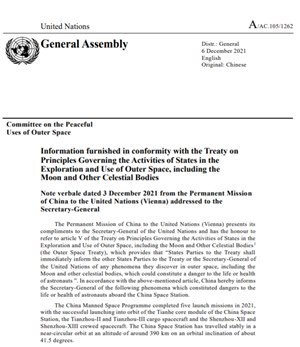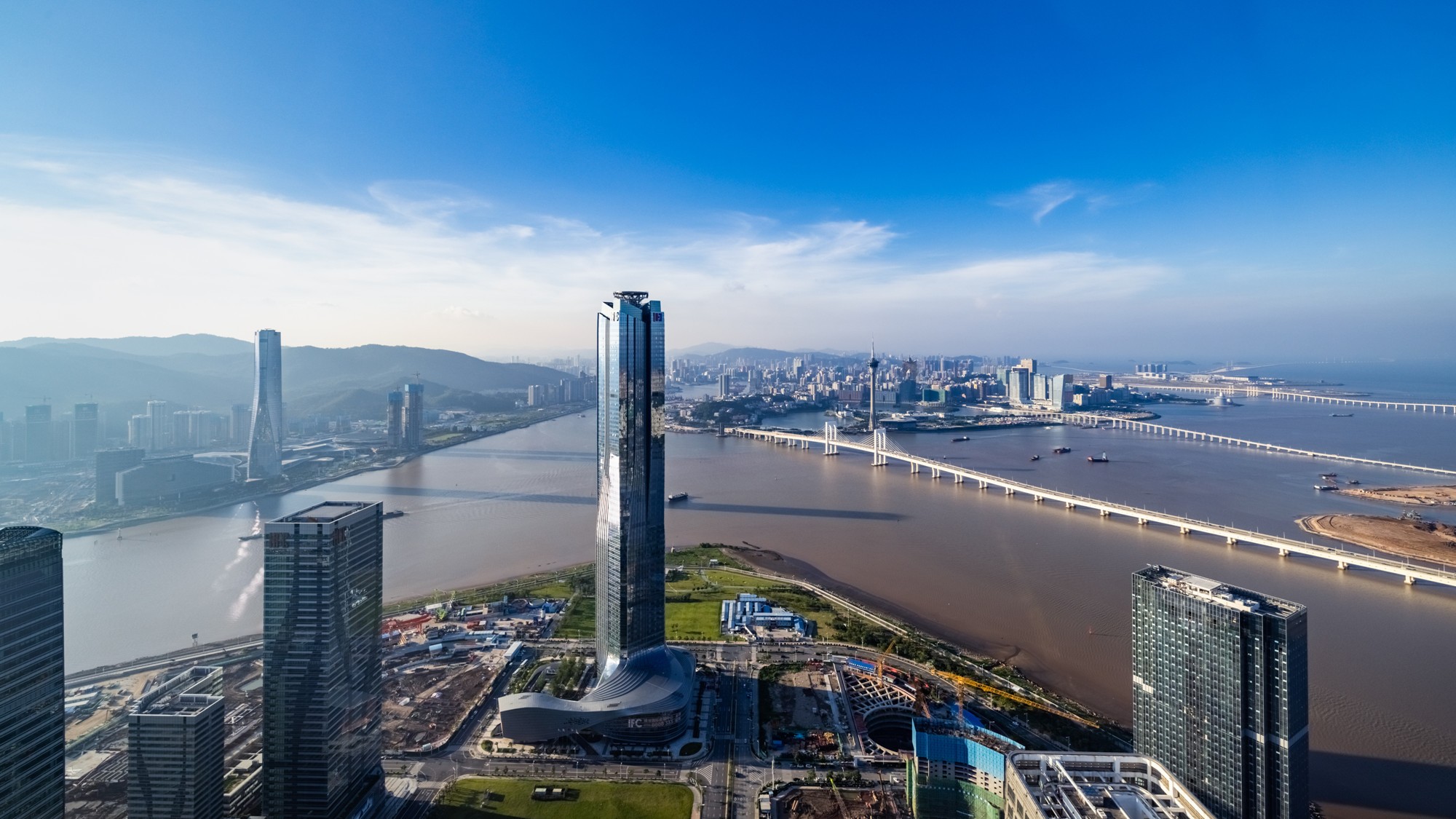【澳門導報 ・ 專題】星鏈衛星兩次危險接近中國空間站如何避免空間衝突?(一)
撰文 | 張志會(中國科學院自然科學史所副研究員)
來源:《返樸》(微信ID:fanpu2019)
前言:
2022年6月1日,中國科學院自然科學史所副研究員張志會受邀在國際知名政策研究平臺東亞論壇(East Asia Forum)發表題為 “Avoiding a collision course over space privilege ”(《避免空間許可權衝突》)的英文評論文章,對2021年美國“星鏈”衛星兩次險些撞上中國空間站的事件進行了評論。作者指出,在人類共有的太空軌道上,各方都應遵守“交通規則”,避免在太空中橫衝直撞。加強信息公開和風險管理,增強各方在太空安全方面的合作,符合中美兩國乃至全人類在太空中的共同長遠利益。
2021年4月29日中國空間站天和核心艙順利發射升空。中國2021年12月6日向聯合國寫的一封投訴信顯示,依據《外太空條約》(Outer Space Treaty)第五條條款,“條約締約國應立即將其在外太空,包括月球和其他天體中發現的可能危及宇航員生命或健康的任何現象通知條約其他締約國或聯合國秘書長”,中國特通知秘書長美國以下威脅中國空間站宇航員生命或健康安全的現象[1]:2021年,美國埃隆·馬斯克(Elon Musk)的太空探索技術公司(SpaceX)發射的兩顆“星鏈”(Starlink)衛星分別從500公里和555公里的近地軌道突然下降,與正在約390公里近圓形軌道上穩定運行的中國空間站進行了兩次近距離接觸。2021年5月16日至6月24日,星鏈衛星-1095衛星連續運行至382公里左右的軌道,然後停留在該軌道上。2021年7月1日該衛星與中國空間站發生了近距離接觸。10月21日,星鏈衛星-2305一直自主運動,且運動策略未知,軌道誤差難以評估。當時中國空間站搭載了我國三名宇航員,一旦發生意外後果不可設想。出於安全考慮,中國空間站分別於2021年7月1日和10月21日實施了預防性緊急處理,改變空間站“天和”核心艙的運動軌道,以避免和星鏈衛星的碰撞。中方作為負責任的太空大國,願請聯合國向外太空條約所有締約國分發上述信息,並提請它們注意。對美方這種罔顧中國空間站及正在太空中執行任務的宇航員的安全的行為,中方外交部表示了強烈譴責。

圖:中國就星鏈衛星兩次險些撞上中國空間站,向聯合國提交的文件
關於事件發生的原因,有四種主要猜測及相關解釋。第一種是SpaceX公司在其星鏈衛星壽命結束時,主動降低這些衛星的軌道高度,讓其脫離軌道。2019年,一顆星鏈衛星在測試自動脫軌技術後,就曾險些與歐洲航天局的一顆氣象衛星相撞。第二種解釋是SpaceX降低星鏈衛星的軌道,以縮短星地通訊延遲,從而促進星鏈衛星系統達到當初宣稱的全球網絡通訊的預定目標。第三種解釋是星鏈衛星發生失控,這在此前已有先例。還有一種解釋是,這是一種授命於美國軍方的蓄意空間測試。
注:未完待續。歡迎瀏覽網頁下方張志會教授受邀在國際知名政策研究平臺東亞論壇(East Asia Forum)發表的題為 “Avoiding a collision course over space privilege ”(《避免空間許可權衝突》)的英文評論文章原文。
附:
The post Avoiding a collision course over space privilege first appeared on East Asia Forum
Wed, 01 Jun 2022 00:00:55 +0000
Author: Zhihui Zhang, Chinese Academy of Sciences
The core module of the China Space Station (CSS) was launched into space in April 2021. In July and October 2021, two SpaceX Starlink satellites suddenly dropped from a low earth orbit of 500km and 555km, respectively, into the CSS’s path. The CSS made an emergency manoeuvre to avoid a collision. China condemned the United States at the United Nations, claiming the incident threatened the CSS and its astronauts.
There are two popular explanations as to why the incident occurred. One is that it was an accident, as SpaceX actively deorbits its satellites at the end of their lives. A Starlink satellite nearly collided with a European Space Agency’s meteorological satellite in 2019 after testing its automatic deorbiting technology. The alternative explanation is that it was a deliberate act by the US military.
Whatever the reason, Washington should not use the pretext of ‘corporate behaviour’ to shirk its responsibility for the actions of SpaceX as a signatory of the outer space treaty.
China’s note to the UN is a reminder that the United States needs to be a responsible space power. In a submission to the UN in 2022, Washington claimed that the possibility of a collision was tiny because of Starlink’s automatic evasion system — the efficacy of which has been questioned by China. Besides increasing the risk of spacecraft collision, the irresponsible behaviour of Starlink satellites in low earth orbit also threatens the safety of astronauts from Japan, the United States, Russia and China.
Starlink is a plan to seize low earth orbit resources as one of its main objects. Relying on recyclable rockets and its ability to launch multiple satellites with one rocket, SpaceX has launched cheap satellites, whose technology has not fully matured, in low-cost batches justified by the ‘public welfare’ gained from having access to high-speed broadband internet. The US Federal Communications Commission has granted SpaceX permission to fly 12,000 Starlink satellites.
SpaceX plans to send up to 42,000 Starlink satellites into low earth orbit, most likely taking up over 80 per cent of low earth orbit resources. Other countries may have to spend a great deal of money to buy low earth orbit resources occupied by SpaceX in the future. The situation will deteriorate should the company refuse to sell its resources or refuse to disclose plans to change their satellites’ orbits under the pretext of protecting trade secrets.
This bizarre incident may have hidden military purposes. Some launch sites are built in Vandenberg Air Force Base of the US, and the technical verification test is included in the content of confidential interconnection between satellites and Air Force fighters. In 2019, SpaceX received funding from the US air force to test the encrypted Internet services between the Starlink satellites and military aircraft. In May 2020, the US Army signed an agreement with SpaceX to test the use of Starlink broadband for cross military network data transmission. In October 2020, SpaceX won a $150 million contract to develop a military version of the Starlink.
The latest Starlink incident will further enhance China’s awareness of space defence — potentially triggering a space race between Beijing and Washington to seize low earth orbit resources. China has over the last few years been trying to integrate earlier satellite constellations (around 600 satellites) into a state-owned satellite communication network on a scale far smaller than the Starlink plan.
Private enterprises are improving their competitiveness, with Huawei’s satellite networking plan and Deep Blue Aerospace’s breakthrough in rocket recovery technology changing the industry. China proposed its own ‘Space-Ground Integrated Information Network’ in 2022 to integrate existing space assets, mobile networks and future telecommunications.
Facing fierce international competition for low earth orbit resources, institutional measures need to be taken to ensure that China, the United States and private stakeholders can cooperate to achieve space security.
Countries should strengthen the management of global low earth orbit resources. A specialised UN agency should be created to revise the previous ‘first come, first served’ principle for space resources. They should also partially restrict the arbitrary occupation of low earth orbit resources that occurs when enterprises and institutions launch massive satellites without constraints. Those responsible for threatening the safety of astronauts should be included in a list for condemnation — with provisions for appropriate economic sanctions.
Private space companies should be obligated to uphold the ‘space order’. NASA outlined its concerns about the SpaceX proposal in February 2022, yet nothing was done to improve the satellite’s faulty automatic collision avoidance mechanism. In response to this, countries should strengthen shared risk management strategies and maintain the stable operation of space facilities to help private space companies avoid these incidents and reshape the Chinese–US space competition.
Space stakeholders should formulate guidelines for international cooperation in outer space. These universal guidelines should refer to a set of operational instructions clarifying the obligations of one country’s spacecraft when approaching another country’s spacecraft — including the timely prediction of collision risk, disclosure of necessary information and active communication with other space agencies.
Following these regulations will help promote Chinese–US cooperation in space security. In common space orbit, all parties should abide by the ‘traffic rules’ and refrain from rampaging through space.
Zhang Zhihui is Associate Professor at the Institute for History of Natural Sciences at the Chinese Academy of Sciences.
The post Avoiding a collision course over space privilege first appeared on East Asia Forum.
(Source : https://www.eastasiaforum.org/2022/06/01/avoiding-a-collision-course-over-space-privilege/)







